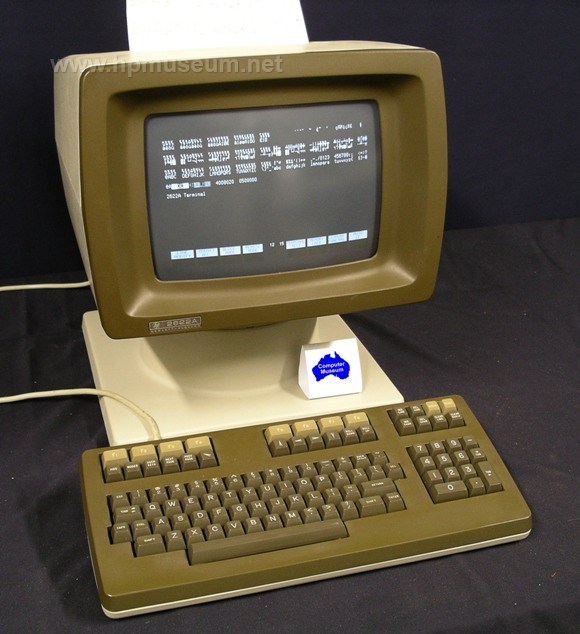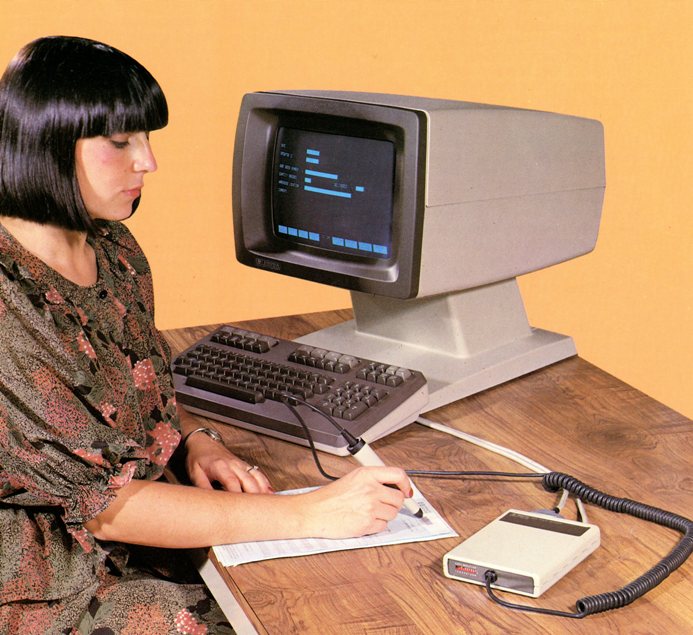Computer Systems
 | Terminals Selection: |
| Name: 2621A | |
| Product Number: 2621A | |
| Introduced: 1978 | |
| Division: Data Terminals | |
| Ad: Click to see | |
| Original Price: $1450 | |
| Catalog Reference: 1980, page 636 | |
| Donated by: Ian Caine, Australian Dairy Corporation. |
Description:
The 2621A was the first of the new "ET Head" terminals. Its CRT was 6 by 8.5 inches and displayed 24 lines of 80 characters in a 9 x 15 character cell matrix. The 2621P was introduced at the same time and priced at $2550; it included an internal thermal printer. HP got 300 orders for the new terminals within a week of introduction. HP shipped over 2,000 of the 2621 terminals in October of 1979.
The 2626A was introduced in 1980 and featured a display that could be split into four separate windows. The 2624A ($2,750) was introduced in October of 1980, and positioned between the low end 2621 nad high-end 2626.
The 2622A was introduced in 1981 ($2,075) and offered display enhancements including inverse video, underline and blinking. The 2623A ($3,750)was introduced in the same year and was the first graphics terminal of the 262X series. It supported graphics resolution of 512 x 390 dots. The 2624B was also introduced in 1981 ($2,890) and featured extra memory to hold downloaded forms and had advanced edit checks.
The 2621B was introduced in November of 1981. This terminal was developed by HP in Grenoble. The development team consisted of: Jean-Pierre Pillou, Joel Setton, Jacques Lacroix, Yves Bonfort, Jean-Loup Gauthier and Jean-Marc Julia. By the middle of 1983, the 2621B had proven to be HP's most reliable terminal ever. With 2,000 hours of usage in a year, the average 2621B would fail once in 10 years. The 2621B used significantly fewer components than the 2621A. The 2621B included only a single processor, whereas the 2621A had three separate processors.
The 2622D was designed specifically for use with the HP 250 computer system. The 2622D and 2649D are the only terminals that can be used to boot the pedestal version of the 250. Use WS/260 to emulate a 2622D on a standard PC.
The 2626W was introduced in late 1981 at $4950 specifically as a word processing terminal running HPWORD off of 3000 systems. The 2626W had 64K of local RAM to hold documents and free the central CPU. The 2625A was introduced in September of 1983 at $3495. It was a dual-use terminal offering 2622A capability on port 1 and IBM 3276 features on port 2. It also came with a tilt and swivel base. The orange-screen 2628A word processing terminal was also introduced in 1983, priced at $3195.
HP also sold the same terminals to OEMs under different model numbers. For example, the 2929E OEM terminal is equivalent to the 2622A and the 2929L OEM terminal is the same as a 2621B.
Sales of 262X terminal were significantly affected by the introduction of the 2392A in 1984. The 2621 and 2622 were obsoleted in January of 1985. The 2627 and 2628 were obsoleted in March of 1986. The 2624 was obsoleted in October of 1986.

Collector's Notes:
Unlike many other HP products, you cannot change the rated AC input voltage for these terminals via an external switch and fuse slot. To change the voltage rating, remove the top case and power board at the rear of the terminal. The power board has either a jumper or switch for changing the voltage rating as well as a replaceable fuse. While you have the power board out, you will want to replace the metalised paper capacitor(s) on it as they are prone to failure (and smoking) with age.
Almost all 262X Series terminals have an affliction that looks like "screen mold". These spots are unsightly and can affect the viewability of the screen, but they have no affect on functionality. The "screen mold" is not actually mold, but a degradation of the glue layer that holds a glass cover onto the terminal CRT. A procedure (including photos) for fixing this problem is outlined on the 9835 page.
Almost all 262X terminals suffer from moderate to severe UV fading of the housing. You can restore the original color of the terminal using Retr0bright or an Australian product called Orange Power Sticky Spot and Goo Dissolver.| Back | More Images | Product Documentation | Category Accessories |
^ TOP©2004 - 2025 BGImages Australia - All Rights Reserved.
The HP Computer Museum and BGImages Australia are not affiliated with HP Inc. or with Hewlett Packard Enterprise. Hewlett Packard and the HP logo are trademarks of HP Inc and Hewlett Packard Enterprise. This website is intended solely for research and education purposes.
